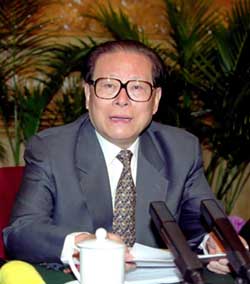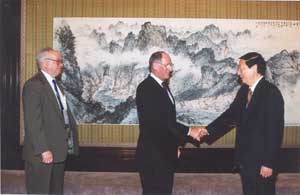
Report
On the State of the Environment In China
2 0 0 2
National Symposium on Population, Resources and Environment
|
|
| On March 10, 2002, the National Symposium on Population, Resources and Environment was convened in Beijing. Secretary General of The Central Committee of Chinese Communist Party, also the President of China, Mr. Jiang Zemin presided over the meeting and made an important speech. |
|
|
Premier Zhu Rongji meets the foreign participants of the 3rd China Council for International Cooperation on Environment and Development. |
In 2002, The Central Committee of Chinese Communist Party convened the National Symposium on Population, Resources and Environment (NSPRE) for hearing the report on the environmental protection and making important arrangements for further strengthening the environmental protection. It was the sixth time successively that the NSPRE was held during the Chinese People’s Congress and the Chinese People’s Political Consultative Conference sessions. The Report of 16th Congress of the Chinese Communist Party raised a higher demand on the environmental protection in the new century and listed the environmental protection in the overall targets for building up a well-off society in all-round way. It also took the capacity building for sustainable development and the ecological environmental improvement as one of the four important targets, which brings great opportunities as well challenges to the environmental protection. The State Council convened the 5th National Environmental Protection Conference early in the year for carrying out the 10th National Five-Year-Plan (FYP) of Environmental Protection and clarifying the targets and tasks for environmental protection in the 10th FYP period.
In 2002, the national environmental quality was basically maintained at the level of the previous year, while the national GDP grew by 8% and the population grew by 0.645%. The discharges of COD in wastewater, the emission of sulfur dioxide, soot and industrial dusts in waste gases, and disposal of industrial solid wastes were all reduced. The “33211” key treatment project was further implemented and the water quality in the “three rivers and three lakes” was basically stable. Improvement of the air quality was seen in some cities. Considerable progress was made in the ecological construction with ecological conservation enhanced, but the ecological situation was still not satisfactory. The seven major river basins were polluted to different extents, and only less than 1/3 of the river sections monitored met the requirement of water quality for Grade III. The pollution in Hai River and Liao River basins were most severe. The nitrogen and phosphorus pollution in Dianchi Lake, Tai Lake and Chao Lake was serious. The offshore pollution in the East Sea and Bohai Sea was relatively severe. The urban air quality was basically stable, and the number of cities in which the air quality exceeded the Grade II standards reduced slightly. The particulate pollution covered relatively large area. The sulfur dioxide pollution in some cities was severe. The concentration of nitrogen dioxide in all cities reached national Grade II air quality standards. The coverage and extent of acid rain pollution was stable. The acid rain pollution in the South was relatively severe, and acid rain occurred in 90% of the cities in the acid rain control region. Light noise pollution was found in most cities. The radioactive environmental quality was still maintained at the natural baseline level.

